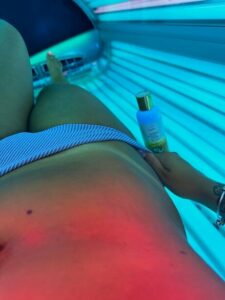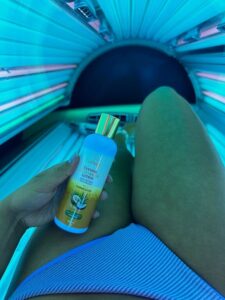Many tanning bed enthusiasts are unaware of the hidden danger lurking in their tanning lotions. Some tanning lotions contain ingredients that can not only damage their skin but also destroy the very equipment they rely on for a bronzed complexion. In this article, we will explore the dangers of certain tanning lotions and provide tips on choosing a safe and effective product for your tanning needs.

Why is tanning lotion so important?
It is highly recommended that all clients utilise a sunbed-safe tanning lotion while using a sunbed. This essential step not only enhances the outcome of your tan but also initiates the tanning process within a mere 30 seconds. Moreover, tanning lotion offers additional advantages such as combating the visible effects of ageing, preventing any unpleasant odours associated with tanning, nourishing and softening the skin, and maintaining optimal hydration levels. In addition, it enables UV rays to penetrate deeper into the skin’s layers, resulting in a more profound tan rather than just superficial colouration.
Certain tanning lotions have been specifically formulated to be compatible with tanning equipment. These formulas are carefully crafted to ensure that none of the ingredients will cause any harm to the sunbed acrylics. However, it’s important to note that this is not the case for many non-tanning products that are brought into salons. Non-tanning products are typically not designed with the same level of consideration for salon-equipment care. If a salon has a policy prohibiting the use of oil to safeguard their equipment, it is essential to honour their decision. In such cases, opting for the stand-up version is recommended.
Understanding the risks: how some tanning lotions can damage your tanning beds
It is crucial to have a thorough understanding of the potential risks associated with specific tanning lotions. If selected without caution, these lotions can not only harm your skin but also cause significant damage to your tanning bed equipment.
Avoid using products like baby oil, Vaseline, and petroleum jelly for tanning purposes. These products are not formulated for tanning and lack the necessary UV-specific ingredients and skincare components required to protect your skin while achieving a tan. Mineral oils have the tendency to amplify UV exposure, making overexposure and burning more likely. Furthermore, alcohols and preservatives in some lotions can dry out your skin, resulting in short-lasting tan results that do not nourish, hydrate, or rejuvenate your skin or combat signs of ageing.
Indoor tanning particularly emphasises the relevance of this information. Sunbed acrylics cannot process mineral oils (not to be confused with “plant-based oils”). During the tanning session, the acrylic will expand and contract as it adjusts to the heat. If mineral oils are absorbed by the acrylic, it becomes clouded and visibly affected. Once absorbed by the acrylic, these oils cannot be removed and hinder its ability to expand and contract properly – ultimately leading to cracking and rendering the equipment unusable. Replacing damaged acrylics is costly for salons and using such equipment becomes unsafe until a new acrylic is installed.
Furthermore, some tanning lotions contain ingredients that may react negatively with the materials used in tanning bed construction. For example, certain lotions contain bronzers or DHA (dihydroxyacetone), which are designed to enhance the tanning process by darkening the skin. However, if these ingredients come into contact with the acrylic surface of the bed, they can cause discolouration or even irreparable damage.
To protect both your skin and your tanning bed, it is essential to choose tanning lotions that are specifically formulated for indoor tanning. Look for lotions that are labelled as “tanning bed safe” or “compatible with indoor tanning equipment.”
By understanding the risks associated with certain tanning lotions and taking proactive measures to protect your tanning bed, you can ensure a safe and long-lasting tanning experience. Choose your lotions wisely, prioritise the health of your skin and the longevity of your equipment, and enjoy the benefits of a beautiful, bronzed glow.
The common culprits: ingredients to avoid in tanning lotion.
Spray oils are a product that tanning brands may offer, but it ultimately depends on the salon’s discretion whether to allow them. Some brands create spray oils for both indoor and outdoor tanning. However, it is important to verify the ingredients listed on the bottle or check the brand’s website for any specific instructions regarding their use on sunbeds.
Salons should also consider if using spray oils is appropriate for their facility, especially if they have a hard floor. The careless application can result in oil spilling onto the floor, creating a potential slip hazard for customers and future equipment users. Additionally, trigger sprays can potentially mark walls by spraying oil onto them, causing cleanliness issues in salon spaces.
To ensure safety and cleanliness in your salon, be cautious when deciding whether to accept spray oils and take necessary precautions to prevent accidents and maintain a clean environment.
Protecting your investment: tips for preventing damage to your tanning beds
Investing in a tanning bed is a significant financial commitment, and it’s important to take proper care of your equipment to ensure its longevity and performance. By following these tips, you can protect your investment and avoid costly repairs or replacements.
- Clean regularly: Regular cleaning of your tanning bed is essential to prevent the buildup of residue, oils, and sweat. Use a mild, non-abrasive cleaner recommended by the manufacturer to clean the bed’s surface, acrylics, and lamps. Avoid using harsh chemicals or abrasive materials, as they can damage the bed’s components and reduce its lifespan.
- Avoid excessive moisture: Moisture can be detrimental to the electrical components of your tanning bed. Ensure that the area where the bed is placed is properly ventilated and free from excessive humidity. If possible, use a dehumidifier to control the moisture levels in the room. Additionally, wipe down the bed after each use to remove any moisture or sweat.
- Monitor lamp usage: Overuse of tanning bed lamps can lead to premature burning out and reduced performance. Follow the manufacturer’s guidelines for lamp usage and replace them at the recommended intervals. Avoid using lamps that are past their expiration date, as they may emit harmful UV rays or provide inconsistent tanning results.
- Use protective eyewear: Always wear appropriate protective eyewear when using a tanning bed. UV radiation can be harmful to your eyes, and failing to protect them can lead to long-term damage. Purchase goggles specifically designed for tanning bed use and ensure that they provide adequate protection. Replace them regularly to maintain their effectiveness.
- Check for damage: Regularly inspect your tanning bed for any signs of damage or wear and tear. Look for cracks, discolouration, loose wires, or malfunctioning components. If you notice any issues, contact a professional technician or the manufacturer for repairs. Ignoring or attempting to fix the problem yourself can cause further damage and compromise your safety.
- Follow manufacturer’s guidelines: Always refer to the manufacturer’s instructions and guidelines for proper use, maintenance, and troubleshooting of your tanning bed. They have the expertise and knowledge to provide specific recommendations for your equipment. Adhering to their guidelines will ensure that you are using the bed correctly and minimizing the risk of damage.
By implementing these tips, you can extend the lifespan of your tanning bed and protect your investment. Regular cleaning, proper maintenance, and responsible usage will not only ensure optimal performance but also provide a safe and enjoyable tanning experience. Take the necessary precautions to preserve your tanning bed and enjoy the benefits of a beautiful, sun-kissed glow for years to come.
Making informed choices: finding tanning lotions that are safe for your equipment
When it comes to tanning lotions, not all products are created equal. Using the wrong tanning lotion can not only harm your skin but also damage your expensive tanning bed. It is crucial to make informed choices and select tanning lotions that are specifically designed to be safe for your equipment. Here are some tips to help you find the right tanning lotions:
- Read product labels: Before purchasing any tanning lotion, thoroughly read the product labels. Look for phrases like “safe for tanning beds” or “bed-friendly” to ensure that the product won’t cause any harm to your equipment. Avoid lotions that contain ingredients known to cause damage, such as oils, bronzers, or glitter particles that can clog the filters or damage the acrylic surface of your tanning bed.
- Seek recommendations: Reach out to professionals in the tanning industry, such as salon owners or experienced tanners, for recommendations on tanning lotions that are compatible with your specific tanning bed. They can provide valuable insights and suggest reliable brands or specific product lines that have been tested and proven to be safe for tanning beds.
- Research reputable brands: Conduct thorough research on reputable tanning lotion brands known for producing high-quality products. Look for brands that prioritize the safety of tanning beds in their formulations. Check customer reviews and ratings to gauge the effectiveness and compatibility of the tanning lotions with various tanning bed models.
- Consult your tanning bed manufacturer: If you’re unsure about which tanning lotions to use, contact your tanning bed manufacturer for recommendations. They can provide you with a list of approved tanning lotions that are compatible with your specific equipment. Following their guidelines will ensure that you don’t void any warranties and maintain the optimal performance of your tanning bed.
- Test before continuous use: Even if a tanning lotion claims to be safe for tanning beds, it’s always a good idea to perform a patch test before using it regularly. Apply a small amount of the lotion on a discreet area of your tanning bed, such as the corner, and observe any adverse reactions or damage. If there are no issues, you can proceed to use the lotion confidently.
- Clean your tanning bed regularly: Regardless of whether you use tanning lotions that are safe for your equipment, it is crucial to clean your tanning bed regularly. Remove any residue or buildup from the surface, acrylics, and lamps to prevent any potential damage. Regular cleaning will ensure the longevity and optimal performance of your tanning bed.
By making informed choices, doing thorough research, and following the guidelines provided by professionals and manufacturers, you can find tanning lotions that are safe for your equipment. Taking the necessary precautions will not only protect your tanning bed from damage but also ensure a safe and enjoyable tanning experience.
Conclusion: prioritise the longevity and effectiveness of your tanning beds
It is evident that using tanning lotions that can damage tanning beds is a significant concern within the tanning industry. The potential risks to equipment and the overall satisfaction of customers highlight the need for the industry to address this issue and advocate for safer practices.
By taking action and prioritising the longevity and effectiveness of tanning beds, the industry can ensure that customer investments are protected. Tanning beds are a significant financial investment for both salon owners and individuals, and using incompatible tanning lotions can lead to expensive equipment damage. Providing guidance and recommendations on safe tanning lotions is paramount to preserving these investments.
Additionally, the industry must ensure customer satisfaction by promoting the use of tanning lotions that are safe for equipment. Tanning enthusiasts rely on their tanning beds to achieve their desired results, and damaged equipment due to improper use of tanning lotions can result in frustration and dissatisfaction. By advocating for safe practices and educating customers, the industry can ensure a positive tanning experience.
Safety hazards are also a concern when incompatible tanning lotions are used. Damaged tanning beds may malfunction or become unstable, increasing the risk of accidents or injuries. Addressing this issue and promoting safe practices prioritise the safety and well-being of everyone involved, including customers and salon staff.
It is important for the tanning industry to prioritize the longevity and effectiveness of tanning beds, as this helps to establish trust and credibility. One way to do so is by addressing the issue of incompatible tanning lotions, which shows the industry’s commitment to customer satisfaction and safety. This commitment can lead to repeat business and positive recommendations, ultimately contributing to the industry’s success.
Another crucial aspect of prioritizing the longevity and effectiveness of tanning beds is promoting responsible tanning. The industry has a responsibility to provide access to safe and effective tanning products and can contribute to a culture of responsible tanning by advocating for safer practices and educating customers about the importance of using compatible tanning lotions.
Upholding industry standards is also essential for maintaining the reputation of the tanning industry. Addressing the issue of tanning lotions that can damage equipment ensures that the industry adheres to established standards and regulations. This commitment to maintaining high standards showcases the industry as reliable and responsible, further building customer trust.
In conclusion, prioritizing the longevity and effectiveness of tanning beds is crucial for the tanning industry. By taking action to address issues and advocating for safer practices, the industry can protect customer investments, ensure satisfaction, prevent safety hazards, build trust and credibility, promote responsible tanning, and uphold industry standards. These efforts will ultimately contribute to a safer and more enjoyable tanning experience for all. It is important for the tanning industry to prioritize the longevity and effectiveness of tanning beds, as this helps to establish trust and credibility. One way to do so is by addressing the issue of incompatible tanning lotions, which shows the industry’s commitment to customer satisfaction and safety. This commitment can lead to repeat business and positive recommendations, ultimately contributing to the industry’s success.


